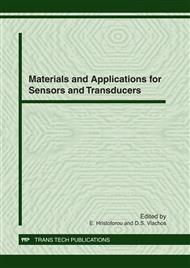p.1
p.5
p.9
p.13
p.18
p.23
p.28
p.33
Study of the early Stage of Deposition Process for Electrodeposited Ni100-XFeX Thin Films
Abstract:
The aim of this work is to understand the early stages in the growth mechanism of invar (Fe64Ni34) alloys and also to study the influence of potential on the evolution of their crystalline structures. Fe64Ni34 layers were deposited onto copper substrates under optimal conditions using the electrochemical method of cyclic voltammetry (CV) and chronoamperometry (CA). The influence of the potential is examined and the nucleation kinetics is discussed. In this purpose, the obtained experimental data was interpreted by applying useful theoretical methods developed by Scharifker and Hills. X-ray diffraction experiments were performed on all samples in order to follow the structural evolution of Fe64Ni34 layers as a function of the potential.
Info:
Periodical:
Pages:
1-4
Citation:
Online since:
November 2011
Price:
Сopyright:
© 2012 Trans Tech Publications Ltd. All Rights Reserved
Share:
Citation:


